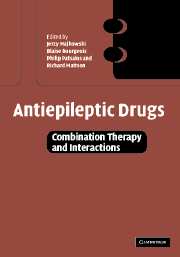
- Cited by 2
-
Cited byCrossref Citations
This Book has been cited by the following publications. This list is generated based on data provided by Crossref.
Perucca, Emilio 2006. Clinically relevant drug interactions with antiepileptic drugs. British Journal of Clinical Pharmacology, Vol. 61, Issue. 3, p. 246.
Knezevic, Claire E and Marzinke, Mark A 2018. Clinical Use and Monitoring of Antiepileptic Drugs. The Journal of Applied Laboratory Medicine, Vol. 3, Issue. 1, p. 115.
- Publisher:
- Cambridge University Press
- Online publication date:
- September 2009
- Print publication year:
- 2005
- Online ISBN:
- 9780511545023
- Subjects:
- Neurology and Clinical Neuroscience, Medicine




